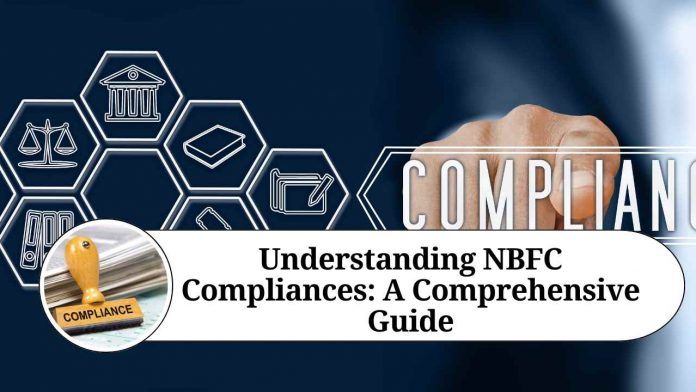Introduction
Non-Banking Financial Companies (NBFCs) play a significant role in the financial landscape by providing a wide range of financial services. However, like any other financial institution, NBFCs are subject to various regulations and compliances to ensure the stability and integrity of the financial system. In this blog post, we will delve into the world of NBFC compliances, exploring the key requirements and guidelines that NBFCs must adhere to.
- Registration and Licensing:
The first step for any entity wishing to operate as an NBFC is obtaining registration from the regulatory authority, which in many countries is the central bank or financial regulatory body. The application process typically involves submitting detailed documentation, such as the business plan, financial statements, and background checks of directors and shareholders. Once approved, the NBFC is granted a license to carry out its financial activities.
- Net Owned Fund (NOF) Requirement:
NBFCs are required to maintain a minimum level of Net Owned Funds (NOF) as prescribed by the regulatory authority. NOF refers to the company’s owned capital (equity shares, preference shares, etc.) minus the investments in shares of other companies, the book value of debentures, and other specified assets. The NOF requirement acts as a financial buffer and ensures that NBFCs have adequate capital to support their operations.
- Capital Adequacy Ratio (CAR):
Similar to banks, NBFCs are also required to maintain a minimum level of capital adequacy to safeguard against financial risks. The Capital Adequacy Ratio (CAR) is calculated as a percentage of a company’s risk-weighted assets. It measures the proportion of capital (equity and reserves) to the risk-weighted assets, providing a measure of the NBFC’s ability to absorb losses. The specific CAR requirement may vary based on the nature and size of the NBFC’s operations.
- Prudential Norms:
NBFCs are subjected to prudential norms to ensure their financial soundness and stability. These norms encompass guidelines related to income recognition, asset classification, provisioning for bad debts, and exposure limits. Adherence to these norms ensures that NBFCs maintain transparency in their financial reporting and effectively manage credit risks.
- KYC and Anti-Money Laundering (AML) Regulations:
To prevent money laundering and terrorist financing, NBFCs are required to implement robust Know Your Customer (KYC) procedures. This involves verifying the identity of customers, assessing their risk profiles, and conducting due diligence checks. Additionally, NBFCs are expected to monitor and report any suspicious transactions to the relevant authorities, following Anti-Money Laundering (AML) regulations.
- Fair Practices Code:
NBFCs are expected to follow a Fair Practices Code to promote ethical and responsible lending practices. This code outlines guidelines related to loan applications, loan appraisal, transparency in loan agreements, grievance redressal mechanisms, and debt recovery practices. Adherence to the Fair Practices Code helps protect the interests of borrowers and ensures fair treatment to all stakeholders.
- Reporting and Compliance:
NBFCs are required to submit periodic reports and disclosures to the regulatory authority. These reports include financial statements, prudential returns, and other specified information. Compliance with reporting requirements is crucial to maintain transparency and allow regulators to monitor the financial health and compliance status of NBFCs.
Conclusion
NBFCs are an integral part of the financial ecosystem, providing vital financial services to individuals and businesses. The regulatory framework surrounding NBFCs aims to maintain the stability, transparency, and integrity of the financial system.
Other Related Blogs: Section 144B Income Tax Act
Frequently Asked Questions (FAQs)
Q1: What is an NBFC?
A1: NBFC stands for Non-Banking Financial Company. It is a financial institution that provides various financial services such as loans, advances, investments, asset financing, and credit facilities, similar to banks. However, unlike banks, NBFCs cannot accept demand deposits from the public.
Q2: What are NBFC compliances?
A2: NBFC compliances refer to the set of rules, regulations, and guidelines that NBFCs must adhere to in order to operate legally and maintain financial stability. These compliances include registration and licensing requirements, maintaining minimum Net
Owned Funds (NOF), Capital Adequacy Ratio (CAR), following prudential norms, implementing KYC and AML regulations, adhering to a Fair Practices Code, and fulfilling reporting and compliance obligations.
Q3: How does an NBFC obtain registration and licensing?
A3: To obtain registration and licensing as an NBFC, the company needs to apply to the regulatory authority in its jurisdiction, usually the central bank or financial regulatory body. The application process involves submitting detailed documentation such as the business plan, financial statements, background checks of directors and shareholders, and fulfilling specific criteria set by the regulatory authority.
Q4: What is Net Owned Fund (NOF)?
A4: Net Owned Fund (NOF) refers to the owned capital of an NBFC, calculated by deducting investments in shares of other companies, the book value of debentures, and other specified assets from the company’s owned capital (equity shares, preference shares, etc.). NBFCs are required to maintain a minimum level of NOF as prescribed by the regulatory authority as a measure of financial strength.
Q5: What is Capital Adequacy Ratio (CAR)?
A5: Capital Adequacy Ratio (CAR) is a measure of an NBFC’s capital strength and ability to absorb losses. It is calculated as a percentage of a company’s risk-weighted assets. CAR ensures that an NBFC has sufficient capital (equity and reserves) in proportion to its risk exposure. The specific CAR requirement may vary based on the nature and size of the NBFC’s operations.
Q6: What are prudential norms for NBFCs?
A6: Prudential norms are guidelines that NBFCs must follow to maintain financial soundness and stability. These norms include income recognition, asset classification, provisioning for bad debts, and exposure limits. Adhering to prudential norms ensures transparency in financial reporting and effective management of credit risks.
Q7: What are KYC and AML regulations for NBFCs?
A7: Know Your Customer (KYC) and Anti-Money Laundering (AML) regulations are measures implemented by NBFCs to prevent money laundering and terrorist financing. KYC procedures involve verifying the identity of customers, assessing their risk profiles, and conducting due diligence checks. NBFCs are also expected to monitor and report any suspicious transactions to the relevant authorities, following AML regulations.
Q8: What is the Fair Practices Code for NBFCs?
A8: The Fair Practices Code outlines guidelines for ethical and responsible lending practices by NBFCs. It covers areas such as loan applications, loan appraisal, transparency in loan agreements, grievance redressal mechanisms, and debt recovery practices. Adhering to the Fair Practices Code ensures fair treatment to borrowers and protects the interests of all stakeholders.
Q9: What reporting and compliance obligations do NBFCs have?
A9: NBFCs are required to fulfill reporting obligations by submitting periodic reports and disclosures to the regulatory authority. These reports include financial statements, prudential returns, and other specified information.




















